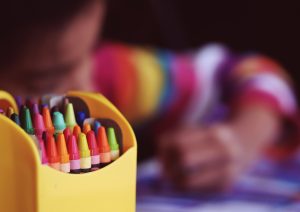Over the past couple of years, schools are shifting away from the arts and towards more of the core subjects of math, science, reading, and writing. However, studies are showing parents who dismiss art are depriving children of critical early development. According to recent research by the National Endowment for the Arts, arts such as drawing and painting develop essential social skills, regulate emotional expressions, and improve language and communication among children with autism and nonverbal learning disabilities. If you’re looking to add art to your curriculum or want to encourage some imagination in your child’s life, check out these tips to let the creativity flow in a healthy and positive environment.

Photo by Aaron Burden on Unsplash
Start small and build up
Your child will most likely want to start by drawing their favorite Avengers superhero or the prettiest My Little Pony. However, you need to make sure that you start small. Begin with simple shapes such as circles, triangles, and squares. Tell your child or student that this is the basis of any drawing or painting they will create in the future. Then you can come up with some more fun yet easy drawings such as the sun, clouds, dragonflies, butterflies, rabbits, dogs, and spiders.
Give step by step instructions
Children with NVLD can become easily frustrated with multi-step instructions and transition changes. Therefore, you will want to make sure that you give step-by-step directions that are concise, easy to follow, and very literal. When you’re moving to each step, give several verbal cues and review the previous steps before introducing the new ones. You may want to provide written instructions to go along with your verbal directions and draw the steps together multiple times.
Don’t do too much at once
You should constantly be on the lookout for overstimulation or signs of frustration. This can be manifested through the balling of a fist, irritability, changes in breathing, or backing away from the project. If you see any of these behaviors, you will want to take a break from your creativity and simply calm the mind. Allow the child to walk around, take a nap, or read a book. Any activity that allows them to refresh their brain will help them reset for the next set of instructions.
Stay positive and praise their work
All kids respond well to positive reinforcement. At the end of the day, you want them to love art and the amount of freedom and creativity that comes with it. Therefore, tell your child how amazing their drawings or paintings are and don’t restrict them. If they want to draw a purple sun, let them. They should love art and see it as a means of relaxation and self-expression.
Art is a great way for children with NVLD to learn essential social skills and create an outlet to express themselves. When you’re teaching your child how to draw or paint, be sure to create a fun, positive, and healthy environment.
Sally
Sally is a professional freelance writer with many years experience across many different areas. She made the move to freelancing from a stressful corporate job and loves the work-life balance it offers her. When not at work, Sally enjoys reading, hiking, spending time with her family and traveling as much as possible.
Share your own story







